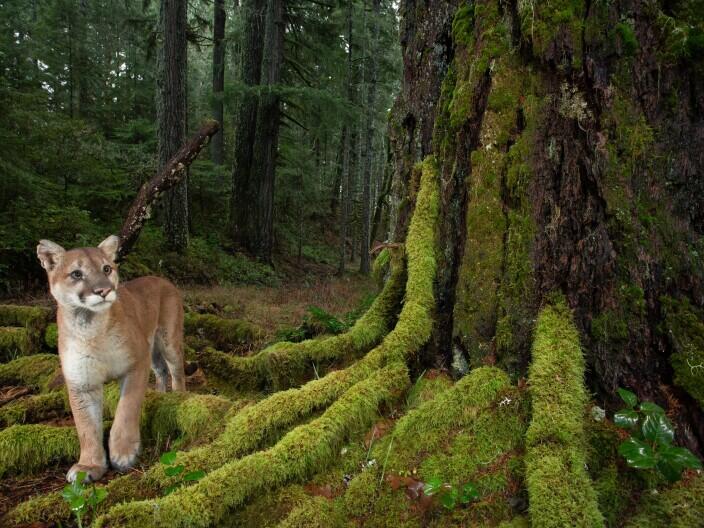Physical Address
304 North Cardinal St.
Dorchester Center, MA 02124
Physical Address
304 North Cardinal St.
Dorchester Center, MA 02124

“As humans, our everyday lives are sustained by the behaviors and interactions of forest organisms,” writes photographer David Herasimtschuk of old growth forests. “Yet, because these processes and relationships occur in places and at scales rarely observed, our connection with forest biodiversity and the role it plays in nurturing our well-being often goes completely unnoticed.”
Over the past decade, Herasimtschuk has captured the essence of forests across the Pacific Northwest in photographs, highlighting the importance of preserving these last remaining old-growth ecosystems. His work showcases the intricate ecosystems of these forests, from the soulful presence of bears and mountain lions to the delicate existence of salamanders and salmon.
These images not only emphasize the beauty of these creatures but also underline the symbiotic relationships vital to the forest’s health and, by extension, our planet’s welfare. To better understand his mission, we spoke to Herasimtschuk about his photographic journey and the critical message behind his work.
Protecting intact, mature, and old-growth forests globally has emerged as a vital and cost-effective solution to mitigate climate change impacts. However, adequate policy to manage these forests for ecosystem health and carbon storage has been limited.
The temperate rainforests of western North America have the highest carbon storage potential of any forest type in the world. Recognized as invaluable ecosystems, they are at the center of ongoing conflicts between the timber industry and conservation efforts.
Herasimtschuk’s photo essay is a timely reminder of our relationship with these forests. There are currently numerous policy initiatives aimed at creating new frameworks for forest health and old-growth protection in the Pacific Northwest. This includes protecting mature forests, seen as the upcoming old-growth generation.
These legislative actions also include policies to modify how private and state forests are managed, modernizing forest protection on federal lands. Following an executive order from the Biden administration in 2022, the U.S. Forest Service plans significant updates to the National Forest Plan and Northwest Forest Plan this year.
With discussions on the fate of Pacific Northwest forests ongoing, it’s crucial that the public and policymakers understand forest functions and make informed, science-based decisions regarding forest management.
Herasimtschuk’s journey through the Pacific Northwest began in 2011, focusing on old-growth forests since 2022. His goal is to create a comprehensive ecosystem aesthetic through wide-angle images that place species or humans within their forest habitats.
In particular, he captures the profound connections between forests, rivers, and fish, showcasing how ancient forests provide essential nutrients and conditions for species like salmon, which in turn sustain the forest.
By combining images of fish and forests, Herasimtschuk hopes to highlight the vital role of forest management in salmon conservation.
Herasimtschuk has learned that not all forests are equal, and how we manage them dramatically impacts numerous species and processes. Old-growth forests, once considered merely timber crops, are now valued as critical natural systems. But a history of extensive logging has left many of these forests depleted, impacting ecosystem services that humans depend on.
One of the most fascinating lessons Herasimtschuk has learned is the complex symbiosis within these forests. For example, as salmon return to spawn, they bring nutrients that nourish trees. Specific tree species can grow significantly faster due to these nutrients. As salmon populations decline, these critical nutrients diminish, affecting the ecological potential of the forests.
The significance of smaller species, like salamanders, also stands out. These cryptic species play a crucial role in the global carbon cycle. By preying on insects that decompose leaves, which releases carbon dioxide, salamanders help keep carbon sequestered in the forest floor.
Documenting wildlife in these forests requires a wide array of gear. Herasimtschuk uses tools like underwater housings and drysuits for aquatic life, and camera traps for large mammals. Each shot often involves extensive hiking and patience to find the best locations.
Collaboration with scientists is pivotal for Herasimtschuk. Working closely with researchers from areas like the H.J. Andrews Experimental Forest, he creates imagery that brings scientific findings to life, aiming to engage and educate the public about forest ecosystems.
His favorite images often come from camera traps, which can take months to perfect. These images convey the scale of old-growth trees and the wildness of forest habitats, featuring subjects like mountain lions and bears.
While photographing forest life can be challenging and unpredictable, the occasional successful shot offers a unique and intimate view of these environments, helping to raise awareness about their significance.
Ultimately, Herasimtschuk hopes his work will help people understand the value of biodiversity and the interconnections within forest ecosystems. By sparking curiosity and wonder, he aims to encourage deeper engagement with and understanding of the natural world, fostering a connection that is essential for conservation efforts.
Source: NPR



